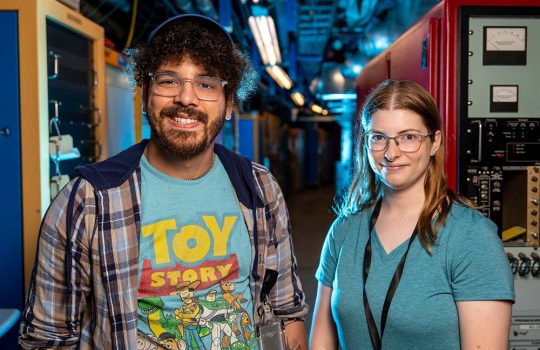BATAVIA, Illinois—The Education Office of the Department of Energy’s Fermilab greets the new school year with another complete program of classroom presentations to celebrate the World Year of Physics, marking the 100th anniversary of Albert Einstein’s “Miraculous Year.”
“We reach many students throughout the area with our presentations each year,” said Susan Dahl of Fermilab’s Education Office, “but we’re hoping to reach even more as a way of celebrating the year in which Einstein published the four papers that forever changed the way we view our world.”
The age-appropriate World Year of Physics presentations, taught by Fermilab scientists and geared toward students from grades 2 through 12, are brought free of charge to classrooms, libraries and after-school programs, or to other informal science activities. From “Zap! Light and Color” (Grades 2-6) to “Space, Time and Einstein” (Grades 7-12), the presentations and presenters have made lasting impressions throughout Fermilab’s surrounding school communities.
“I was very pleased with Fermilab’s World Year of Physics presentations,” said Anne Barney of St. Peter’s school in Geneva, Illinois. “The presenters were very knowledgeable, well-prepared, and entertaining. The presentations, perfectly geared toward the student’s grade level, consisted of discussions, visual aids, and hands-on activities. The Fermilab WYoP presentations also introduced to the children a variety of careers in science.”
For fifth-grade teacher Sarah Garcia of Stevenson Elementary School in Melrose Park, Illinois, the classroom presentations even surpassed the experience of a field trip. “I have never seen any of my students so attentive and interested in any educational presentation before,” Garcia said. “They were eager to participate, and eager to show everyone else what they had learned. Our presenter was wonderful and tried to give every student a chance to participate. He even allowed the students to come up after the presentation and work with the demonstrations that they didn’t get to participate in. In my opinion, this was the best ‘field trip’ we had all year. I would highly recommend this to any teacher, and plan to ask Fermilab to come out again this year.”
Classroom presenters are scientists, engineers and technical experts who are dedicated to making educational connections with children in Fermilab’s surrounding communities. Senior scientist Michael Albrow offers “Space, Time and Einstein,” a topic which at first glance appears difficult to translate into hands-on activities: how does one demonstrate relativity? Hula hoops provided one answer.
“To demonstrate bending space, which is a general relativity principle, we had hula hoops with latex sheets stretched across them,” Albrow said. “In the center we placed a heavy steel ball that created a depression in the latex sheet, representing the gravitational welt, then we started a little ball going around and around in circles, heading down toward the big body. We had the kids holding the hula hoops, four kids to each hoop, and we gave no lecture—we just let them have fun.”
Scientist Don Lincoln, who offers “Forces and Motion” (Grades 4-8), noted the active participation, and the sense that the students found science interesting, with applications to their daily lives. “The kids had fun and they all were volunteering to be assistants,” Lincoln said. “They all were offering suggestions when we asked them what they thought would happen. The teachers were grateful to have scientists in the classrooms. With travel budgets so curtailed, this was an inexpensive alternative to a fieldtrip. I was really impressed with just how engaged the students and teachers were.”
The sense of engagement is also rewarding to presenters. Albrow described being touched by the thank-you messages sent from all the members of one class he had visited. “That made it all worthwhile, although it’s also icing on the cake,” he said. “We’re not trying to turn the kids into scientists. We would just like every kid to be exposed to the fun of physics, and to our enthusiasm. We want to show that girls can do science, too—that’s very important, that they can do what they’re interested in doing. And we want to show them how science works, that you always have to test an idea with an experiment.”
The World Year of Physics classroom presentations are offered free of charge to schools within an approximate radius of 90 minutes’ drive from the Fermilab site, which is 40 miles west of Chicago. A brochure with descriptions of all the offerings can be downloaded from the Education Office Website at: http://www-ed.fnal.gov/pdf/wyp_brochure.pdf. To schedule a classroom presentation, contact Nancy Lanning at 630-840-5588. For questions about the program or the presentations, contact Susan Dahl at 630-840-3094.
For more information on the World Year of Physics 2005, an international celebration of physics endorsed by the United Nations, go to: http://www.physics2005.org/
Fermilab is a U.S. Department of Energy Office of Science national laboratory, operated under contract by Universities Research Association, Inc.



